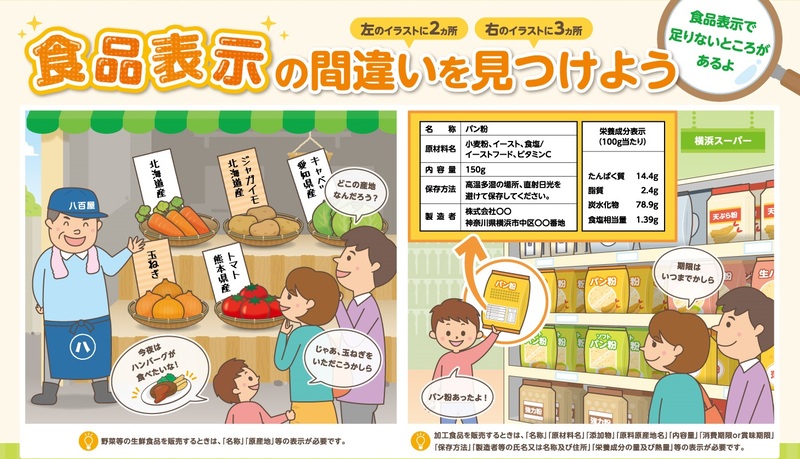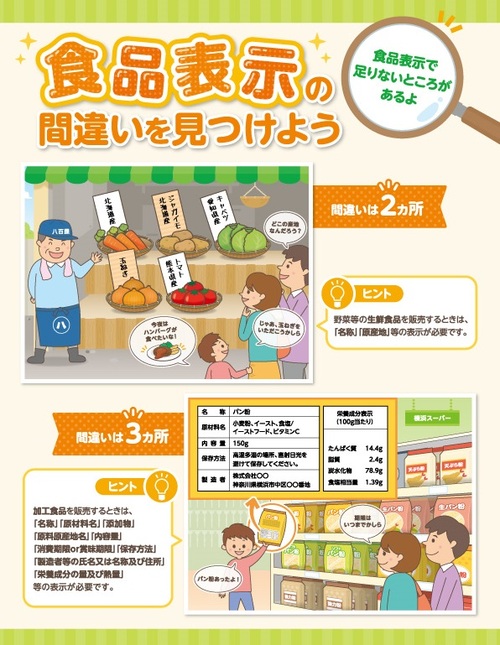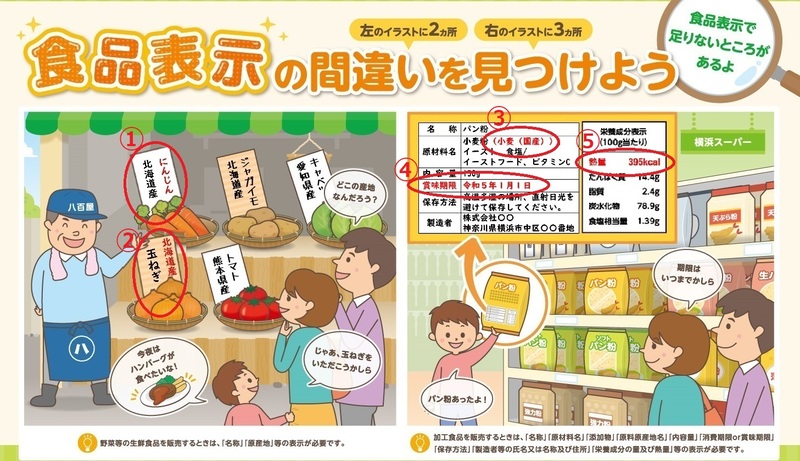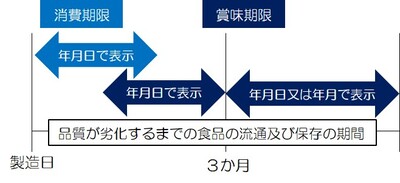- Yokohama-shi Top Page
- Health, Medical Care and Welfare
- Health and Medical Care
- Food safety
- Food Safety Yokohama WEB
- Thing about food labeling
- Finding errors related to food labeling
Here's the text.
Finding errors related to food labeling
There is a mistake in food labeling in the illustration! Let's look for a mistake!
Last update date April 17, 2024
Problems
There are five mistakes in total. If you find a mistake, let's check the answer!
The difference between horizontal and vertical versions are the same.
 Problem illustration (horizontal version)
Problem illustration (horizontal version)
 Illustration (vertical version)
Illustration (vertical version)
Search for errors in food labeling (PDF: 5,888KB)
Answers
Answers

Illustration illustration
Commentary
①No carrot "name" is not displayed
②There is no indication of "origin" of onion
When selling fresh foods such as vegetables, it is necessary to indicate "name" and "origin of origin". In the case of fresh foods, it is also possible to display close to the product or use the display on packaging bags and boxes, as shown in the illustration. If you want to check the place of origin such as vegetables, check it out!
③There is no indication of "raw material origin" of breadcrumbs
In the case of processed foods, it is necessary to display the "raw material origin" of the product.
Origin of raw materials
"All processed foods (excluding imported products)" manufactured and sold after April 1, 2022 indicate the place of origin of raw materials.
The content displayed varies depending on whether the most raw material contained in the product is fresh or processed food.
When the most raw material in the product is fresh food

If the most raw material is fresh food, the production area is indicated as "XX". For foreign products, it is displayed as "country name", and for domestic products, "domestic", "prefecture name", "municipal name", and "generally well-known place name" are displayed. [Example] Canadian, domestic and Kanagawa Prefecture
When the raw material contained in the product is processed food

If the most raw material is processed food, the manufacturing site is indicated as "XX Manufacturing". [Example] Manufacturing and Domestic Manufacturing
In addition, if the production area of fresh food, which is the largest raw material used in the raw material, is known, the place of origin may be indicated. [Example] Flour (Wheat (Hokkaido))
Origin
It refers to the place where fresh food (agricultural products, livestock products, marine products) grew or harvested.
Whereas the origin of raw materials is indicated on processed foods, fresh foods indicate the origin of origin.
☑ Agricultural products
In the case of domestic products, the names of prefectures, municipalities, and places that are well known to the general public.
In the case of imported goods, the country of origin
☑ Livestock products
In the case of domestic products, the name of the prefecture, the name of the prefecture, the name of the prefecture, the name of the city, the name of the prefecture, the name of the city, the name of the prefecture, the name of the city, the name of the prefecture, the name of the prefecture, the name of the city, and the well-known place name is also acceptable.
In the case of imported goods, the country of origin
☑ Marine products
In the case of domestic products, the name of the landed water area or the name of the prefecture where the farm is located (however, if it is difficult to display the name of the water area, the name of the port where it was caught or the name of the prefecture is also possible.)
In the case of imported goods, the country of origin
Country of origin
Imported processed foods must be labeled the country where the food was manufactured (the country of origin).
For more information, please refer to the Consumer Information (General Food Labeling).
④There is no indication of "expiration date" of breadcrumbs
For processed foods, the expiration date display (expiration date or expiration date) is required.
There are two types of expiration dates for foods: "expiration date" and "expiration date". The "expiration date" is displayed on foods whose quality deteriorates rapidly and should be consumed promptly, and the "expiration date" is the "expiration date" It is displayed on foods whose quality is relatively less likely to deteriorate. Normally, the expiration date or expiration date must be displayed until the "date", but for foods whose expiration date must be displayed, those that have a period from the date of manufacture to the expiration date exceeds 3 months, It is permitted to be displayed as "Date".

⑤There is no indication of "heat amount" of breadcrumbs
Nutrition ingredient label requires labeling of "heat", "protein", "lipid", "carbohydrate", and "salt equivalent" are required. If you are worried about calories and salt content, check the figures!
Let's check the brochures and videos!
Information on Food Labeling
If you would like to know more information about food labeling, please see Consumer Information (General Food Labeling) and Consumer Information (Nutrient Labeling).
In order to open PDF files, you may need a separate PDF reader.
If you do not have it, you can download it free of charge from Adobe.
![]() To download Adobe Acrobat Reader DC
To download Adobe Acrobat Reader DC
For inquiries to this page
Food hygiene section, Medical Care Bureau Health and Safety Department
Phone: 045-671-3378
Phone: 045-671-3378
Fax: 045-550-3587
Email address: ir-syokuhineisei@city.yokohama.jp
Page ID: 584-838-462







